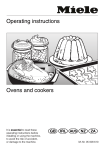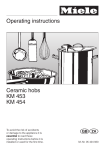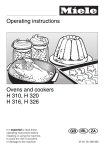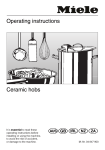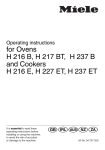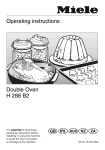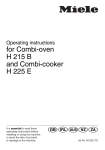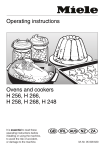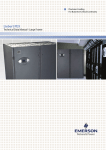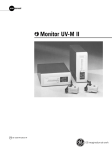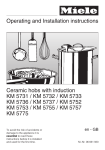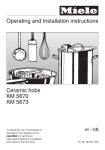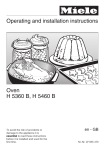Download Miele H 212 E Operating instructions
Transcript
Operating instructions H 212 B oven H 212 E cooker It is essential to read these operating instructions before installing or using the machine, to avoid the risk of accident, or damage to the machine. Q\@ä} M.-Nr. 04 325 741 Caring for the environment Disposal of the packing material The transport and protective packing has been selected from materials which are environmentally friendly for disposal and can normally be recycled. Rather than just throwing these materials away, please ensure they are offered for recycling. Disposal of your old machine Old machines contain materials which can be reclaimed or recycled. Please contact your dealer, your local waste collection centre or scrap merchant about potential recycling schemes, before disposing of the appliance. Ensure that the machine presents no danger to children. Contents Description of the appliance . . . . . . . . . . . . . . . . . . . . . . . . . . . . . . . . . . . . . . . . . 4 Warning and Safety instructions . . . . . . . . . . . . . . . . . . . . . . . . . . . . . . . . . . . . . 6 Safety feature . . . . . . . . . . . . . . . . . . . . . . . . . . . . . . . . . . . . . . . . . . . . . . . . . . . . 11 Before using for the first time. . . . . . . . . . . . . . . . . . . . . . . . . . . . . . . . . . . . . . . 12 Hobs Controls . . . . . . . . . . . . . . . . . . . . . . . . . . . . . . . . . . . . . . . . . . . . . . . . . . . . . . . . . 14 Description. . . . . . . . . . . . . . . . . . . . . . . . . . . . . . . . . . . . . . . . . . . . . . . . . . . . . . . 15 Use. . . . . . . . . . . . . . . . . . . . . . . . . . . . . . . . . . . . . . . . . . . . . . . . . . . . . . . . . . . . . 16 Oven Description of the systems. . . . . . . . . . . . . . . . . . . . . . . . . . . . . . . . . . . . . . . . . . . 18 Use. . . . . . . . . . . . . . . . . . . . . . . . . . . . . . . . . . . . . . . . . . . . . . . . . . . . . . . . . . . . . 19 Use of the clock / timer . . . . . . . . . . . . . . . . . . . . . . . . . . . . . . . . . . . . . . . . . . . . . 22 Applications – Baking . . . . . . . . . . . . . . . . . . . . . . . . . . . . . . . . . . . . . . . . . . . . . . . . . . . . . . . . 26 – Roasting . . . . . . . . . . . . . . . . . . . . . . . . . . . . . . . . . . . . . . . . . . . . . . . . . . . . . . . 30 – Defrosting. . . . . . . . . . . . . . . . . . . . . . . . . . . . . . . . . . . . . . . . . . . . . . . . . . . . . . 33 – Casseroles . . . . . . . . . . . . . . . . . . . . . . . . . . . . . . . . . . . . . . . . . . . . . . . . . . . . . 34 – Grilling . . . . . . . . . . . . . . . . . . . . . . . . . . . . . . . . . . . . . . . . . . . . . . . . . . . . . . . . 35 Maintenance Cleaning and care – Ceramic hobs . . . . . . . . . . . . . . . . . . . . . . . . . . . . . . . . . . . . . . . . . . . . . . . . . . 38 – Enclosed hotplates . . . . . . . . . . . . . . . . . . . . . . . . . . . . . . . . . . . . . . . . . . . . . . 40 – Appliance front, controls, accessories . . . . . . . . . . . . . . . . . . . . . . . . . . . . . . . 41 – Oven interior . . . . . . . . . . . . . . . . . . . . . . . . . . . . . . . . . . . . . . . . . . . . . . . . . . . 42 Correcting minor faults. . . . . . . . . . . . . . . . . . . . . . . . . . . . . . . . . . . . . . . . . . . . . . 50 After sales service . . . . . . . . . . . . . . . . . . . . . . . . . . . . . . . . . . . . . . . . . . . . . . . . . 53 Extra accessories. . . . . . . . . . . . . . . . . . . . . . . . . . . . . . . . . . . . . . . . . . . . . . . . . . 54 Installation / Electrical connection Electrical connection . . . . . . . . . . . . . . . . . . . . . . . . . . . . . . . . . . . . . . . . . . . . . . . 55 Installation – Ceramic hob . . . . . . . . . . . . . . . . . . . . . . . . . . . . . . . . . . . . . . . . . . . . . . . . . . . 58 – Hob with enclosed hotplates . . . . . . . . . . . . . . . . . . . . . . . . . . . . . . . . . . . . . . . 60 – Oven with hob controls . . . . . . . . . . . . . . . . . . . . . . . . . . . . . . . . . . . . . . . . . . . 62 – Oven . . . . . . . . . . . . . . . . . . . . . . . . . . . . . . . . . . . . . . . . . . . . . . . . . . . . . . . . . 66 Description of the appliance H 212 E b Indicator light for oven heating c Control light for hob cooking areas d Oven function selector e Oven temperature selector f Timer g cooking zone control: front left h cooking zone control: back left i cooking zone control: back right j cooking zone control: front right k Facia panel l Data plate m Heating element for top heat and grilling o Runner heights 1, 2, 3, 4, 5 p Door contact switch q Oven door with ventilation r Oven door locking with guard plate n Air inlet for fan 4 Description of the appliance H 212 B b Indicator light for oven heating c Oven function selector d Oven temperature selector e Timer Accessories – 2 baking trays Please note This page shows the control panel of the H 212 B. Details of the oven interior and door illustrated on the previous page also refer to the H 212. – dual purpose grill pan / oven tray – Non-tip rack for baking, roasting or grilling – Roasting filter to be attached in front of the fan aperture before fan oven roasting For “B” model ovens, only the instructions relating to ovens are applicable. The instructions for hobs relate to “E” model ovens with hob controls, or to the hob of a free-standing cooker. Data plate for hob A second data is supplied with the hob, as the one on the appliance is not visible after installation. Please stick this into the space provided on the “After Sales Service” page for future reference. The droplets of fat caught up in the circulating air are deposited on the roasting filter. This helps to keep the oven and especially behind the interior back wall cleaner. 5 Warning and Safety instructions This appliance complies with all relevant legal safety requirements. Improper use of the appliance can, however, present a risk of both personal injury and material damage. Before installation and before using the appliance for the first time, read the operating instructions carefully. They contain important notes on safety, on the operation and care of the appliance. This way you will avoid the risk of accidents and damage to the appliance. Do not let children access the appliance or its controls. Supervise its use by the elderly or infirm. Keep these instructions in a safe place and pass them on to any future user. Correct usage The appliance is intended for domestic use to cook food, and in particular to bake, roast, defrost, cook, dry fruit etc, and to grill. Any other usage is at the owner’s risk and could be dangerous. The manufacturer cannot be held responsible for damage caused by improper use of the appliance. 6 Technical safety Before connecting the appliance to the mains supply make sure that the voltage and frequency correspond to the rating on the data plate. Consult a competent person if in doubt. The electrical safety of this appliance can only be guaranteed when continuity is complete between the appliance and an effective earthing system, which complies with local and national regulations. It is most important that this basic safety requirement is tested by a qualified electrician. The manufacturer cannot be held responsible for the consequences of an inadequate earthing system. This appliance must only be operated as a built-in appliance. This is necessary to ensure that all electrical components are shielded. Installation work and repairs may only be carried out by suitably qualified and competent persons to ensure safety. Repairs and other work by unqualified persons could be dangerous. Warning and Safety instructions The appliance is only completely isolated from the electricity supply when: – it is switched off at the wall socket – or the mains fuse is withdrawn – or the screw-out fuse is removed (in countries where this is applicable) Do not connect the appliance to the mains electricity supply by an extension lead. Extension leads do not guarantee the required safety of the appliance. Use Caution, danger of burning. High temperatures are produced by the oven and the hob cooking areas. Great care should be taken to ensure that small children do not touch the appliance when it is being used. The hob and also external parts of the oven such as the door glass, vents and control panel can become quite hot. Turn pan handles away from the edge to prevent children from pulling pans over. Oven Use of heat-resistant oven gloves is recommended: – when placing food in the oven, turning or removing it. When working with “Conventional” heating or when grilling, the element in the roof of the oven and the guard become very hot, and there is a danger of being burnt. Wait until the grill element has cooled down before lowering it for cleaning, to avoid the danger of burning. Do not use force to pull it down as this can cause the element to break. Do not heat up unopened tins or jars of food in the oven, as pressure will build up and they will explode. Do not push pots and pans around on the oven floor as this could damage the surface. Do not lean or sit on the open oven door, or place heavy items on it. This could damage the appliance. Take care in the region of the hinges. The oven door can support a maximum load of 10 kg. 7 Warning and Safety instructions Cover any food which is left in the oven to be kept hot. This avoids the food drying out. It also prevents steam condensing and possibly leading to moisture damage in the oven. If food is left in the oven after cooking, e.g. to take advantage of the residual heat, turn the temperature selector switch to “0°C”. Leave the function selector switch at the position set. Do not switch the appliance off until the food has been removed. Otherwise there may be a build-up of condensation which could adversely affect the oven interior, and externally the control panel, the worktop surface or surrounding kitchen furniture. Put any deep frozen products such as pizza on baking paper on the rack. Do not place them on the baking tray or grill pan. This could cause the metal to distort to such an extent that it might be difficult to remove the tray/pan from the oven. The distortion would increase with subsequent use. 8 Ceramic hobs When switched on the cooking areas heat up. A residual heat indicator shows whether a cooking zone is hot. In the event of any breakages or cracks occurring in the ceramic hob it must be switched off immediately and disconnected from the electricity supply. Contact the Service Department. Do not use the hob until the damaged ceramic plate has been replaced. Continued use would be dangerous as liquids etc. boiling over could penetrate to the electrical components through any crack. Do not use the hob as a resting place for any other objects. This could lead to a danger of the article catching fire or melting if there is any residual heat. Do not drop anything on the ceramic hob. Even a light object such as an egg cup, could cause damage in certain circumstances. Warning and Safety instructions Do not allow either solid or liquid sugar or pieces of plastic or alumium foil to get on to the cooking zones when they are hot. If this should occur, turn to a lower setting but do not switch off. Immediately scrape off all the sugar, plastic or aluminium remains from the hob with a shielded razor blade scraper, taking care not to burn yourself. If these residues are allowed to cool before the hob surface has been cleaned, the ceramic surface will be susceptible to pitting or even cracking. Do not use any pots or pans on the ceramic hob with bases with pronounced edges or ridges. These could scratch or scour the hob surface permanently. Enclosed hotplates Avoid allowing liquids or foods containing salt to spill onto a stainless steel hob or trim. Should this happen wipe up any spillages containing salt immediately, to avoid corrosion. Do not use covers on the enclosed hotplates.Turning on the hotplate with the cover still in place could damage the hotplate. Putting a cover on a damp hotplate could lead to damage of the hotplate. Condensation trapped under the cover could cause corrosion. General notes Under no circumstances use a steam cleaner to clean this appliance. Pressurised steam could give rise to a short circuit, or cause permanent damage to the surface and to components, for which the manufacturer of the oven cannot accept any responsibility. Do not leave the appliance unattended when cooking with oils and fats as these can be a fire hazard if allowed to overheat. Do not use plastic or aluminium foil containers. These melt at high temperatures. Additionally they could damage a ceramic hob as they melt. Do not use the oven to heat up the room. Due to the high temperatures radiated, objects left near the oven or hob could catch fire. When using kitchen appliances connected to sockets near the oven, ensure that the cable cannot come in contact with the hot cooking zones or get trapped in a hot oven door, which could melt the cable insulation and be dangerous. 9 Warning and Safety instructions Always ensure that food is sufficiently cooked or reheated. Many factors will affect the overall cooking time, including the size and amount of food, its temperature, changes to the recipe and the shape and size of cooking container. Some foods may contain micro organisms which are only destroyed by thorough cooking, therefore when cooking or reheating foods, e.g. poultry, it is particularly important that food is fully cooked through. If in doubt select a longer cooking or reheating time. It is important that the heat is allowed to spread evenly throughout the food being cooked. This can be achieved by stirring and/or turning the food, and by observing a sufficiently long standing time, which should be added to the time needed for cooking, reheating or defrosting. In countries which may be subject to infestation by cockroaches or other vermin, pay particular attention to keeping the appliance and its surroundings in a clean condition at all times. Any damage which might be caused by cockroaches or other vermin will not be covered by the appliance guarantee. Use of accessories After using the scraper ensure the blade is shielded before putting it away. 10 Keep these instructions in a safe place and pass them on to any future user. Disposal of your old machine Before discarding an old machine switch off and disconnect it from the power supply. Cut off and render any plug useless. Cut off the cable directly behind the machine to prevent misuse. The manufacturer cannot be held liable for damage caused by noncompliance with safety instructions. Safety feature Oven door locking (Exception: appliances in stainless steel and with a bowed handle in the Classic range.) When you shut the oven door the lock catch will automatically engage. A lock is incorporated in the oven door. This makes it difficult for children to open the oven door. To activate the door lock proceed as follows: Open the door completely. To open the oven door hold under the handle and push the lever to the right. The door is now unlocked and can be opened. If the door lock is not needed: Open the door. Push the lock catch to the left into the neutral position. Press the flat lever downwards. This releases the lock catch which springs up. 11 Before using for the first time Timer Oven Use a cloth to wipe out the oven interior with a warm water and detergent solution. Polish dry with a dry cloth. Do not close the oven door until the oven interior is dry. Rinse the accessories. After the appliance has been switched on “0•00" and ”AUTO" flash in the display. Setting the time of day (24 hour display) Press the buttons “g” und “)” at the same time. “0•00" and ”AUTO" continue to flash. Enter the time of day in hours•minutes with the – /+ button. As soon as the – /+ button is pressed in, the symbol “@” lights up and stays on. When the time of day has been entered, the clock advances minute by minute. 12 Fit the side rails supplied. Before using for the first time New appliances have a slight smell on first use. Running the oven for an hour at a high temperature makes it dissipate more quickly. Turn the oven function selector to “Fan Heat D”. Ceramic hob Thoroughly clean the ceramic hob before use, then clean regularly after use when just warm to the touch, or cold. There might be a slight smell on first use due to the drying effect. Select the highest temperature. The timer can be used to set the finish time. Ensure the room is well-ventilated during this process. Enclosed hotplates For the first few times of using a smell will occur. Heat the hotplates for about 5 minutes at the highest setting. Do not place a pan on them. The protective coating which prevents the build-up of rust will smoke slightly as it hardens. 13 Hob controls The controls for the cooking zones / hotplates regulate the heat output. Suggested hob settings Setting Only turn the controls in a clockwise direction until a resistance is felt, and back again. Turning them in the other direction will damage them. When the control is turned to a setting, the control lamp for the cooking area lights up. This goes out when the hob control is turned to “0". Cooking Choose a high setting number for boiling/frying. Switch to a lower setting to continue cooking, when steam is visible at the rim of the lid. Switching to a lower setting at the right time: – avoids pans boiling over, – food sticking, – and saves electricity. Melting butter, Chocolate Dissolving gelatine Preparing junket and yoghurt Keeping food warm Warming small quantitites of food/liquid Thickening sauces containing egg yolk, butter Omelettes Defrosting deep frozen items Cooking rice, pasta, porridge, Steaming fruit, vegetables, Cooking broths, pulse soups Braising meat, fish, vegetables Cooking dumplings, potatoes, soups Preparing jams, jellies, stewed fruit Frying chops, liver, sausage, fish, eggs Frying pancakes, dropped scones and other liquid batters Frying steaks Deep frying (chips, fritters) Boiling water 1-2 1-3 3-5 4-6 7 - 10 9 - 12 These figures, which envisage approx. 4 helpings, should only be taken as a guide. With deep pans, large quantities, or without the lid on, a higher setting is needed. With smaller quantities select a lower setting. 14 Hobs - description Ceramic hobs Diameter of cooking zones The cooking zones are clearly marked on the hob. Only the zone that is switched on heats up. The surround remains relatively cool. Residual heat indicator Each cooking zone has a residual heat indicator. When the zone has been turned on, the indicator light comes on when the zone reaches a certain temperature. The indicator goes out when the heated surface of the hob is cool enough to touch. Extended area n The cooking zone control is also used to switch on the extended area of the left hand cooking zone. Turn the controls in a clockwise direction only to the symbol "n", and allow to spring gently back again. Otherwise the control will be damaged. Then select the setting required. Turning the zone control back to "0" switches off: – the cooking zone, and – the extended area. Enclosed hotplates On hobs with enclosed hotplates, there are two different sizes and performance levels of hotplate. Some hobs have an area for resting hot pans. An indicator light comes on to show when the extended area has been chosen. 15 Hobs - use Choice of suitable pans Size of pan Attention to correct choice and use of pans – will help you obtain the best cooking result most economically, – and generally avoid food boiling over and sticking. Pan bases The diameter of the saucepan or frying pan should be very slightly larger than that of the hotplate/cooking area. Pan lids For maximum economy of electricity when cooking or frying, only use pans with a flat or very slightly concave base. When hot the pan will rest evenly on the hob. Modern saucepans for electric cookers are the most suitable and efficient for use on ceramic cooking zones, or solid hotplates. 16 Cooking with the lid on the pan retains the heat. Hobs - use Notes on the use on hobs (both ceramic and enclosed hotplates) Before switching on, place a saucepan containing water or food to be cooked on the hotplate or cooking area. This prevents unnecessary use of energy or the hotplates warping or burning themselves out. Before starting to cook, make sure that the hotplates or cooking areas and the base of saucepan are clean and dry. This saves extra cleaning later on. Additional notes for ceramic hobs Take care before starting to cook that there is no grit or sand on the surface of the hob. This would scratch the surface, especially if a pan was pushed across. Do not use any pots or pans where the base has ridges or a pronounced edge. These could also cause scratches. Do not push roasting tins or baking trays etc across the ceramic surface. Scratches could occur. Aluminium or stainless steel pans with aluminium bases can leave marks with a metallic sheen on the ceramic surface. Clean these away at the earliest opportunity, (see Section on Cleaning and Care). Never leave boiled-over sugar or syrups, plastic items or aluminium foil on the hob. If this does happen, turn the hob to a lower setting, but on no account switch it off. Use a shielded scraper blade to scrape off the sugar, plastic or foil residue thoroughly. If these residues are allowed to cool before the hob surface has been cleaned, the ceramic surface will be susceptible to pitting or even cracking. Additional notes for enclosed hotplates Do not lay anything wet or damp across the hotplates. If this does however happen, wipe the hotplate clean and switch on briefly to dry. This is necessary to avoid corrosion. 17 Description of the systems Fan Heat D Conventional heating A This system works by the circulation of heated air. With this conventional method of heating, radiant heat is directed on the food from above and below. A fan situated on the back wall of the oven sucks in the air, heats it over a ring element and blows the heated air through the carefully spaced openings in the rear panel of the oven. The oven does not usually need to be pre-heated as the heated air reaches the food straight away. Exception: Pre-heat the oven when roasting sirloin. Pre-heating the oven is only necessary when – baking cakes or baking with a short cooking time. – baking sensitive doughs. – roasting a joint of meat, fillet. Grill , Using the fan heating system you can bake and roast on different levels at the same time. The inner part of the upper heating element acts as the grill. This will glow red a few minutes after switching it on and is then ready for use. The heated air used by this system is of a lower temperature than that used with the “Conventional” heating system. Pre-heat the grill for 5 minutes with the oven door closed, before placing the food on the rack. Defrost G No heating is used. At this setting air at room temperature is circulated by the fan, for gentle defrosting. 18 Oven - use Controls There is an oven function selector and a temperature selector. Function selector – Light H Turns on the oven light independently. – Fan heat D For baking or roasting on several levels at the same time. – Conventional A Top and bottom heat for baking / roasting traditional recipes, for soufflés. – Top heat C For browning dishes, finishing dishes with a cheese topping. – Bottom heat B Use this setting towards the end of baking, to brown the base of a cake. – Defrost G For gentle defrosting of deep frozen foods. With this control you select the oven function required. The selector can be turned clockwise or anti-clockwise. – Grill , For grilling fish and cuts such as chops, steaks, poultry pieces, and kebabs . 19 Oven - use Temperature selector The oven can only be turned on with the oven function selector, when the symbol “@” lights up in the timer display. Press the “i” button. Pre-heating the oven This is only necessary in a few cases. With Fan Heat D – for roast beef and beef fillet. Select the appropriate temperature for the food to be cooked. Turn the temperature selector only in a clockwise direction, and back, otherwise the control could be damaged. Defrost G: Do not set a temperature when seleting “Defrosting”. The temperature can be freely selected within the given range. When the temperature selector is switched to the chosen temperature, the indicator light above this switch comes on. When the temperature is reached, the heating element switches itself off. When the temperature falls below that selected, the heating switches on again automatically. 20 With “Conventional” A – for baking biscuits and cakes with a short cooking time. – for baking some doughs. – for roasting sirloin. Pre-heating Turn the oven selector to the required function. Set the temperature selector to the required temperature. When the indicator light above the temperature goes out for the first time, put the food to be roasted or baked into the oven. Oven - use Rack with safety feature The non-tip safety feature prevents the rack from being pulled right out when it only needs to be partially pulled out. When using the rack push it into the oven so that the safety notches (illustrated) go to the rear of the oven, to meet the notches on the runners. The rack can then only be taken right out of the oven by raising it upwards and then pulling it out. 21 Timer - use Symbols in the display The following symbols appear: l – lights up when a short time is set. AUTO – lights up when a cooking process is selected. – flashes when the cooking time is complete. The timer can: – show the time of day, – switch the oven off, or on and off automatically. Push buttons With the push buttons you can: l – enter a short time as a minute minder. g – enter the duration of a cooking process. ) – enter the end of a cooking process. i – cancel an entered cooking process. – /+ – enter or change times. 22 AUTO and @ – light up as the cooking time proceeds. @ – lights up when the oven can be switched on independently of the timer. Timer - use Time of day Short time (Minute minder) (24 hour display) The minute minder can be used to time any activity in the kitchen, e.g. boiling eggs. When the appliance is first connected to the power supply, or after a power cut "0•00" and “AUTO” flash in the display. To set the time of day: Press the buttons “g” und “)” at the same time. “0•00" and ”AUTO" continue to flash. Enter the time of day with the – /+ button in hours•minutes. As soon as the – /+ button is pressed, “@” lights constantly in the display. Once the time has been entered it proceeds in minute intervals. The short time can be entered independently of another entered process. Enter the short time Press the “l” button. Enter the required time in hours•minutes. “l” appears in the display field. At the end of the short time: – an audible tone sounds for approx. 7 minutes. The audible tone can be cancelled at any time by pressing the “l” button. To alter the time of day: The sequence is similar to setting the time of day: Press buttons “g” and “)” at the same time. Enter the time of day with the – /+ button in hours•minutes. If a cooking process had been entered, this will now be cancelled. 23 Timer - use Controlling length of cooking time automatically Switch off automatically Turn the oven function and temperature selectors to the required settings. Press the “g” button. “0•00" appears in the display field. Use the + button to enter the required time in hours•minutes. “AUTO” appears in the display field. Delaying the start of cooking time Turn the oven function and temperature selectors to the required settings. First enter the cooking time: Press the “g” button. Please note the following: For baking do not delay the start too long. This may affect the rising properties of the dough or cake mixture, as it will dry out. The end of cooking time When the end of cooking time is reached – the oven heating switches off automatically. – an audible tone sounds for approx. 7 minutes. – “AUTO” flashes. The button “i” cancels the audible tone and visual symbol. As soon as the “i” button is pressed the oven heating element comes on again. You must switch off the oven. “0•00" appears in the display. Use the + button to enter the required time in hours•minutes. “AUTO” appears in the display. Now postpone the end of cooking time: Press the “)” button. The time of day plus the cooking time entered appear in the display. Use the + button to postpone the end of cooking time. 24 Turn the oven function and temperature selectors to "0". Timer - use To check and change an entered time It is possible to check times entered for a cooking process, or with the minute minder at any time. Checking Press the button of the time which is to be checked. Cancelling an automatic process. Press the “i” button. Please note: As soon as the cooking process is finished the oven heating element and the light come on again. g The cooking time entered, or the amount of time left to run in a programme in progress is shown. Changing the audible tone ) The end of the cooking process appears. Each time “–” is pressed, a different tone is heard. There is a choice of 3 audible tones. - Press the “–” button. l The short time remaining is shown. Altering Press the button of the time which is to be altered. Use the – /+ button to enter the required time. 25 Baking in the oven The following settings are recommended for baking: Baking with the “Conventional A” setting – Fan Heat D – Conventional A The following baking tins give an evenly browned result: Dark metal or enamel tins with a matt finish are preferable. Heat resistant glass or thermoplastic trays dishes can be used. Baking with the “Fan Heat D” setting Most types of heat-resistant tins or dishes are suitable, including thinwalled and bright, non-reflective metal moulds. Several levels can be used at the same time for baking. The recommended positions are: 1 tray = 1st runner from the bottom 2 trays = 1st and 3rd runners from the bottom 3 trays = 1st, 2nd and 5th runners from the bottom Avoid thin-walled and bright, nonreflective metal moulds. These will give uneven browning results. Pre-heat the oven only for: – cakes / biscuits with a very short baking time, – victoria sponge and similar mixtures. Select runner height, according to height of the item: – 1 or 2 for deep cakes – 2 or 3 for biscuits and shallow cakes When baking moist biscuits, cakes or bread, do not bake on more than two levels. With the “Fan Heat D” setting lower baking temperatures are needed than with the “Conventional A” setting. See the baking charts. 26 Baking in the oven General notes The Baking Chart gives suggestions for temperature, runner height and timing. For even browning – in general select the middle temperature. Increasing the temperature and reducing the time can have an adverse effect on even browning. – Select the runner height according to the recipe and the setting chosen. Place oblong tins in the oven as shown in the illustration. Deep-frozen products such as pizzas should be placed on baking paper on the rack. Use the deeper roasting tray for moist fruit cakes and multi-layer cakes, to minimize splashes in the oven. – Just before the end of baking time test to see if the cake is done. Insert a metal or wooden skewer into the centre. If it comes out clean, without dough or crumbs sticking to it, the cake is ready. 27 Baking Baking chart Fan Heat D Temperature in °C rec. runner from bottom Time in mins. Creamed mixture Sand cake Dried fruit cake Nut cake (tray)1) Nut cake (tin) Fresh fruit cake (tray) Fresh fruit cake (tin) Flan base 1) Small cakes 1) 150 – 170 150 – 170 150 – 170 150 – 170 150 – 170 150 – 170 150 – 170 150 – 170 1 1 1 1 1 1 1 1, 2, 5 50 – 60 70 – 80 20 – 25 60 – 70 35 – 45 45 – 55 25 – 30 20 – 25 Whisked mixture Tart 1) Flan base 1) Swiss roll 1) 160 – 180 160 – 180 160 – 180 1 1 1 25 – 35 20 – 25 20 – 25 Rubbed-in mixture Tart / flan base Nut ring Crumble cake Small cakes 1) Cheesecake Apple pie 1) Savoury pastry 2) 150 – 170 150 – 170 150 – 170 150 – 170 150 – 170 150 – 170 190 – 210 1 1 1 1, 2, 5 1 1 1 20 – 25 40 – 50 40 – 50 15 – 25 75 – 85 55 – 75 25 – 35 Yeast mixtures Crumble cake Fresh fruit cake (tray) Stollen White bread Wholemeal bread 1) Pizza (tray) 1) Apple turnovers 150 – 170 160 – 180 150 – 170 160 – 180 190 – 210 170 – 190 150 – 170 1 1 1 1 1 1 1, 3 35 – 45 45 – 55 45 – 65 40 – 50 60 – 70 40 – 50 35 – 45 Choux pastry 1) Eclairs 160 – 180 1, 3 30 – 40 Flaky pastry 1) 170 – 190 1, 3 20 – 25 120 – 140 1, 2, 5 30 – 50 Meringues Macaroons 1) The times given are calculated on the basis of an oven which has not been pre-heated. With a pre-heated oven shorten times by approx. 10 minutes. 1) Pre-heat oven with "Conventional A“ heat. 2) Pre-heat oven with "Fan Heat D“ and "Conventional A“ heat. 28 Baking in the oven Conventional heat A Temperature in °C Recommended runner height from bottom Time in mins. 160 – 180 160 – 180 180 – 200 160 – 180 180 – 200 160 – 180 180 – 200 180 – 200 1 1 1 oder 2 1 1 oder 2 1 1 oder 2 2 50 – 60 70 – 80 15 – 20 60 – 70 35 – 45 45 – 55 15 – 20 12 – 15 180 – 200 180 – 200 190 – 210 1 1 1 oder 2 20 – 30 15 – 20 15 – 20 180 – 200 180 – 200 180 – 200 180 – 200 180 – 200 180 – 200 230 – 250 1 oder 2 2 1 oder 2 2 1 1 1 oder 2 15 – 20 40 – 50 40 – 50 10 – 15 75 – 85 55 – 75 25 – 35 180 – 200 180 – 200 170 – 190 190 – 210 210 – 230 190 – 210 170 – 190 1 oder 2 1 oder 2 1 oder 2 1 oder 2 1 oder 2 1 oder 2 1 oder 2 35 – 45 45 – 55 45 – 65 40 – 50 60 – 70 40 – 50 20 – 25 190 – 210 1 oder 2 25 – 35 200 – 220 1 oder 2 15 – 20 130 – 150 2 30 – 50 Data given are for guidelines only. Values obtained from a machine designed for the German market. 29 Roasting in the oven We recommend the following settings for roasting in the oven: – Fan Heat D – Conventional A Fan Heat D: Make sure the grease filter is fitted in front of the fan in the back of the oven interior before starting. We recommend roasting in a covered pot L: – This ensures that sufficient stock remains for making gravy. – The oven stays cleaner, too. Roasting pots with a lid, made from earthenware, cast iron, ovenproof china or glass, and roasting foil are suitable. Make sure that the pot and lid have heat-resistant handles. 30 Place the covered pot on the rack. The meat should be put into a cold oven. Exception: Pre-heat the oven to the temperature recommended in the recipe when cooking roast beef or beef fillet. Use shelf position 1 for roasting. Exception: Use shelf position 2 when roasting poultry weighing up to 1 kg, a cut of meat, or fish. The “Fan Heat D” system uses an approximately 40°C lower roasting temperature than the “Conventional” heating system. The bigger the quantity to be roasted, the lower the temperature. When roasting more than 3 kg select a temperature about 10°C lower than the one given in the “Roasting” chart. The roasting process will take a bit longer, but the meat will be cooked evenly and the exterior will become crisp. For roasting directly on the rack K the temperature needs to be about 20°C lower than for roasting in a covered pot L. The Roasting time will depend on the type of meat, the size and thickness of the cut. Roasting in the oven Calculating roasting time: The traditional British method is to allow 15 to 20 minutes to the lb, according to type of meat, plus approx. 20 minutes, adjusting length of time as roasting proceeds, to obtain the required result. Alternatively, multiply the height of the joint by the time per cm for the type of meat, (see the roasting chart). Type of meat Beef / Venison Pork / Veal / Lamb Roast beef / Fillet time per cm height of meat 15-18 mins. 12-15 mins. 8-10 mins. Example: Beef roast, 8 cm high 8 x 15 mins. per cm = 120 mins. roasting time Please note: Do not select a roasting temperature which is higher than that recommended.The meat will become brown, but will not be cooked properly. Useful hints Roasting in a covered pot L Season the meat and place in the pot. Add some knobs of butter or margarine or a little oil or cooking fat. Add about 1/8 litre of water when roasting a big lean joint of meat (2-3 kg) or roasting poultry with a high fat content. Roasting on the rack K Place a little water in the tray. Add a little fat or oil to very lean meat or place a few strips of bacon on the top. Do not add too much liquid to the tray during cooking as this will hinder the browning process. Roasting poultry For a crisp finish, baste the poultry ten minutes before the end of cooking time with slightly salted water. Roasting deep frozen meat Deep frozen meat should be defrosted beforehand. Browning only occurs towards the end of the roasting time. Remove the lid about halfway through the roasting time if a more intensive browning effect is desired. After the roasting process is finished take the roast out of the oven, wrap in aluminium foil and leave to stand for about 10 minutes. This helps retain juices when the meat is carved. 31 Oven roasting chart Oven roasting chart Fan Heat D1) Rec. runner from bottom Conventional A Temp. °C in a pot L2) Time in mins Temp. °C in a pot L2) Time in mins. Rib of beef apprx. 1 kg 1 180-200 100-120 220-240 100-120 Sirloin, Steak 2) apprx. 1 kg 1 4) 190-210 35-45 240-260 35-45 Venison, game apprx. 1 kg 1 180-200 90-120 220-240 90-120 Leg of pork apprx. 1 kg 1 170-190 100-120 210-230 100-120 Rolled pork apprx. 1 kg 1 170-190 100-120 200-220 110-130 Meat loaf apprx. 1 kg 1 170-190 50-60 200-220 50-60 Veal apprx. 1 kg 1 170-190 100-120 210-230 100-120 Shoulder of lamb apprx. 1.5 kg 1 170-190 90-120 210-230 90-120 Poultry 0.8-1 kg Poultry apprx. 2 kg Poultry apprx. 4 kg Whole fish apprx. 1.5 kg 1 4) 170-190 50-60 200-220 50-60 1 170-190 120-150 200-220 120-150 1 160-180 150-180 190-210 150-180 1 4) 160-180 35-55 200-220 35-55 Unless otherwise stated, the times given are for an oven which has not been pre-heated. 1) Fit the grease filter in place when using “Fan Heat D”. 2) When roasting on the rack K, set the temperature 20°C lower than given. 3) Pre-heat the oven when using “Fan Heat D” and “Conventional: A”. 4) 2nd runner from the bottom when using the “Conventional A” setting. The information given in this chart is intended only as a guide. 32 Defrosting in the oven Turn the oven function selector to "Defrost G". Do not select any temperature setting. – Where possible remove the packaging and put the food to be defrosted on a baking tray or into a dish. – All meat and poultry should be fully defrosted before cooking. Do not use the liquids from defrosting. – When defrosting poultry put it on the rack, one level higher than a tray put in to catch the defrosted liquid, so that the meat is not lying in this liquid. It is particularly important to observe food hygiene rules when defrosting poultry. Do not use the liquid from the defrosted poultry. Pour it away, and wash the tray, the sink and your hands. N.B. Put the tray back in the oven if roasting on the rack. – Fish does not need to be fully defrosted before cooking. Defrost so that the surface is sufficiently soft to take herbs and seasoning. Do not refreeze food once it has thawed. The time needed for defrosting depends on the type and weight of the food, and at what temperature it was deep frozen. 33 Casseroles Cassseroles Please note: The following oven settings are recommended: Cover dishes which are to be cooked in their own juice and/or steam, eg duchesse potatoes or vegetables, so that they do not dry out. If there is no lid use aluminium foil or damp cooking parchment. – Fan Heat D – Conventional A The following dishes are suitable for this type of slower cooking: covered pots made of ovenproof glass and china, and earthenware pots, which could also be used as serving dishes. They should have heat-resistant handles and knobs. Put the rack in at the 1st runner height from the bottom, and place the prepared casserole with the food for braising or stewing on this. Select the oven setting and the temperature. Fan Heat D . . . . . . . . . . . . . 170-190°C Conventional A . . . . . . . . . . 190-210°C Cooking times Consult your cook book. Cook without a lid when a crusty finish or topping is required, eg for meat or au gratin dishes. Useful hint One dish can be placed on top of the other. Invert the lid of the bottom dish. Put dishes to be browned at the top. Poaching Fish or fruit can be poached in the oven in a covered dish. Bottling Bottling should only be undertaken by an experienced cook who has received proper training in this method of preserving fruit and vegetables, and understands the implications of the chemical reactions involved. Instructions for bottling in this oven are available from the Miele Home Economist. 34 Grilling in the oven Pre-heat the grill for approx. 5 minutes with the oven door shut. Grilling with the oven door shut saves energy and minimizes cooking smells. Grilling on the rack Preparing food for grilling Clean, wipe and season. Do not salt slices of meat beforehand as this detracts from the taste. Add a little oil if necessary. Other fats quickly become black or cause the food to smoke. A little butter can be added to chicken if desired. Assemble the grill pan and rack as shown. Clean flat fish and slices of fish in the normal way. To enhance the taste add a little salt or squeeze a little lemon juice over the fish. Turn the oven function selector to the“Grill ,” setting. Place the food on the rack. Set the temperature: Food to be grilled temperature Thin cuts such as chops, steak 275°C Thicker cuts such as chicken, kebabs 240°C To grill thicker pieces of food more gradually after an initial high temperature, continue grilling at a lower temperature setting to allow the food to cook through to the centre. 35 Grilling in the oven Insert the grill pan at the appropriate level for the height of the food to be grilled: Basting brush thin cuts = level 3, 4 or 5 thicker cuts = level 1 or 2 Grilling time Flat pieces of fish and meat usually need about 5-6 minutes a side depending on their texture. Thicker pieces need longer. With rolled meat allow approx. 10 minutes per cm diameter. Please note: It is best to grill food of a similar thickness at the same time so that the grilling time for each item does not vary too greatly. Most items should be turned half way through cooking. Useful grilling hints One way of finding out how far through a piece of meat has been cooked is to press down on it with a spoon. – If there is very little resistance to the pressure of the spoon, it is still red on the inside (“rare”). – If there is some resistance, the inside will be pink (“medium”). – If there is great resistance, it is throughly cooked through (“well done”). 36 A basting brush with an angled handle for convenient basting under the grill is available from the Miele Spare Parts Department. Grilling Grill chart Pre-heat the grill for about 5 minutes with the door shut before using. Food to be grilled Runner from bottom Temperature in °C grilling time (mins) * 3 or 4 290 3-5 Flat items of food Beef steaks Kebabs 3 or 4 260 8-12 Escalope 3 or 4 290 10-12 Liver slices 3 or 4 275 8-12 Burgers 3 or 4 210 10-15 Sausages 3 or 4 240 8-10 Chops 3 or 4 275 12-18 Fish fillet 3 or 4 250 10-15 Small trout/mackerel 3 or 4 275 16-20 Toast 3 or 5 240 3-6 Open toasted sandwich 3 or 4 240 4-6 Tomatoes 3 or 4 240 6-10 Bananas 3 or 4 240 6-10 Peach halves 2 or 3 230 6-8 1 or 2 240 50-60 Piece of pork, Ø 7 cm (approx. 1 kg) 1 240 70-80 Mixed grill 1 260 20-25 Thicker grilling cuts Chicken pieces (approx. 1 kg) * Turn half way through the grilling time. All times given are approximate and will vary according to personal taste. 37 Cleaning and care Ceramic hob surface In general you can use the same cleaning agents for the ceramic hob surface as you would for ordinary glass surfaces. Never use scouring agents or pads, or strong cleaners such as oven sprays or stain removers, as these could harm the surface. Clean after each use Any minor spills which have not dried on can be wiped off with a damp cloth or sponge. If washing up liquid or a similar cleaner is used, light blue staining might occur. For stubborn spillages use a shielded razor blade scraper. These stains can be removed with a proprietary ceramic hob cleaning agent, although it may take several applications. Removing marks Then wipe with a damp cloth or sponge. Light marks with a metallic sheen (alluminium desposits) on the hob surface can be removed once the hob has cooled down by using a suitable proprietary cleaner. Lime deposits (caused for example by water boiling over, or damp pan bases) can be removed with vinegar or a proprietary hob cleaner. 38 Clean and care Removal of sugar, or syrups, plastic or aluminium foil Do not let the hob cool down. Scrape the sugar or other residue thoroughly from the hob with a shielded razor blade scraper. When the hob is cool, clean with a proprietary cleaner. Suitable cleaners There are proprietary cleaners on the market for cleaning ceramic hobs. Follow the manufacturer’s instructions. Some cleaners incorporate a silicone ingredient which acts as a protective film on the hob. It makes the hob surface smoother and prevents water and soiling adhering to the surface. However, cooking at high temperatures reduces the effect and the cleaner needs to be reapplied for renewed effect. By always cleaning the ceramic surface with one of these special cleaners you will help to avoid the damage caused by sugar and syrups and aluminium foil deposits. Do not apply to the hob when still hot. After applying the cleaner let it dry and then rub it off using paper kitchen towels. Remove every trace of cleaner from the hob with a damp cloth. It could have an adverse effect on the hob when heated up. 39 Cleaning and care Enclosed hotplates Hotplate surround. Hotplates This can be cleaned with a suitable stainless steel cleaner. Wipe off any spilt food with a damp cloth after the hotplates have cooled off. Use a plastic scouring pad if necessary for stubborn spills. Moisture or dirt must not penetrate the hotplate interior. The hotplates can be scoured, but not the hotplate surround. Do not use any cleaning agent with a scouring effect. Hob trough Do not use any scouring agents or pads as this could scratch. Clean the hob with a hot water and detergent solution. Remove any spills of food or water containing salt as soon as possible, as these could cause corrosion. Where spills have dried on, soak for a short time to make cleaning easier. After cleaning switch on the damp hotplates for a short time to dry out, to avoid corrosion. Occasional treatment with a thin film of oil, or special cleaner for solid hotplates is recommended, (eg "Elektropuzzi" available to order from the Spare Parts dept). 40 Cleaning and care Appliance front and control panel Use a mild cleaning agent or a dash of washing up liquid in hot water. Wipe dry with a soft cloth. Accessories Runners Wash in hot water with washing up liquid, or clean with a stainless steel cleaner. Glass front Baking tray, roasting/grill pan, rack: Do not use a scouring agent, as this would scratch the glass front. For ovens with a white finish we recommend after each use wiping: – the oven door handle and – the control panel with a damp cloth and some washing up liquid. This will avoid spillages being burnt on and becoming impossible to remove. Stainless steel front Never use cleaners containing sand, soda or scouring agents, These will leave scratches. wash and dry after each use. Remove stubborn residues that do not wash away – from stainless steel: with a stainess steel cleaner. – from enamel: Soften residues by soaking with hot water, then brushing with a soft nylon brush or sponge. Roasting filter Clean in washing up liquid and hot water, or in the dishwasher. Use a non-scouring stainless steel cleaner. Apply with an even pressure. Wipe over with a damp cloth and rub dry with a soft cloth. 41 Cleaning and care Oven interior Different surfaces of the oven interior are coated with either b “Clean-Enamel”, or c “Catalytic” enamel. Important: Remove any soiling from the “Clean-Enamel” areas before carrying out the extra cleaning process for “Catalytic” enamel described on the next page. Never use hard brushes, wire wool or scourers, scouring pads, hard sponges or other scouring agents on the enamel coatings. These scratch and damage enamel. b “Clean-Enamel” This is a specially hardened enamel with an extremely smooth surface. Most baking and roasting residues can be easily removed using a sponge cloth, washing up liquid and hot water. The oven cavity and door interior are finished in “Clean-Enamel”. The rear panel which protects the fan is more subject to oil and fat splashes, and has a catalytic coating. With some models, side panels with catalytic coating are fitted, and the removable guard plate above the grill has a catalytic coating. With this arrangement most of the interior “CleanEnamel” is protected, except for the floor and door, which should be cleaned after each use. The oven should be cleaned regularly, preferably after each use. If left too long cleaning becomes unnecessarily difficult and in extreme cases impossible. 42 If something bakes on harder, it can be loosened with a shielded razor blade scraper. It is easier to remove splashes of fruit or cake mixture from the oven and racks while they are still warm. Fruit juice may cause lasting discolouration. Dull patches may remain permanently in the oven tray after roasting or grilling. If an oven spray is used on the Clean-Enamel, follow the manufacturer’s instructions carefully. Important: Oven spray must not come into contact with “Catalytic” enamel. Cleaning and care c “Catalytic” Enamel Because circulating air in the oven deposits oil and fat splashes predominantly on the rear wall of the oven this is coated in catalytic enamel. With some models, side panels with catalytic coating are also fitted, and the removable guard plate above the grill has a catalytic coating. When this catalytic enamel is heated to temperatures above 200°C, oil and grease deposits are removed, except for deposits of spices and syrups. The higher the temperature the more effective the process. To take further advantage of the catalytic properties for cleaning, the “Extra cleaning process” can be used, (see next page). For slight soils the oven can be cleaned manually. Do not wait too long between cleaning sessions as further baking and roasting will cause oil and grease deposits to burn on even harder. Cleaning the catalytic enamel manually Where cooking is carried out at lower temperatures splashes and oil and grease can collect on the catalytic coating. This slight soiling can be cleaned manually as follows: Let the oven cool down and remove the runners. If the roof guard needs to be removed, see below. Wipe down the surfaces using a cloth, soft sponge or soft nylon brush with warm water to which a little washing up liquid has been added. Do not use oven spray, or abrasive cleaning agents. Do not wash these panels in the dishwasher. Any mechanical handling would damage the catalytic enamel. Clean the oven floor (clean enamel) after each use. 43 Cleaning and care Cleaning catalytic enamel using the “Extra cleaning process” Before carrying out the extra cleaning process take out the rack and side panels, and remove any soiling from the “Clean-Enamel” areas. To operate the extra cleaning process: Turn the oven function selector to “Fan Heat D”. Turn the temperature selector to the highest setting. Let the oven operate for about one hour. The length of time will depend on the degree of soiling. It is a good idea to set the finish time for the process using the timer. This way you will not forget to switch the oven off at the end. Wipe over all visible surfaces which are not protected by catalytic liners, especially the oven floor. Every time the oven is used at high temperatures any remaining soiling will gradually disappear. 44 Should the catalytic coating on the back panel or any other catalytic panels fitted become ineffective through improper use or heavy soiling, for example, a replacement can be obtained from your Miele dealer or Miele Spare Parts dept. Cleaning and care For ease of cleaning the oven door can be taken off, the runners, side panels and back panel removed and the top grill element lowered. Please note : the oven door is quite heavy. It should be gripped firmly at the sides when being removed or refitted. To remove the oven door: Open the door fully. Lift up the door until the hinges disengage. Remove door. To re-fit the oven door: Flap down the locking clamps on each door hinge. This locks the hinges. Hold the door as shown above and carefully put the locked hinges into the guide holes until they engage. Open the door fully. Still supporting the door, flip the locking clamps up. It is essential that the locking clamps are flipped up when the door is refitted after cleaning. Otherwise the door could come loose on its hinges. 45 Cleaning and care To remove the runners To remove the catalytic side panels Select the “Light H” setting. Select the “Light H” setting. The oven heater elements must be switched off, to avoid the danger of burning. The oven heater elements must be switched off, to avoid the danger of burning. Take the runners out of the oven. Gently lift and pull out the catalytic side panels. Reassemble in the reverse order, carefully ensuring all parts are correctly in place. Pull on the fixing knob to release it. Take the runners out of the oven. Reassemble in the reverse order, carefully ensuring all parts are correctly in place. 46 Cleaning and care When reassembling the catalytic side panels, ensure they sit correctly. Ease the back lug into the opening in the rear wall panel. Put the runners back into place. Lift the front locating hole on to the guide pin behind the collar. 47 Cleaning and care To remove the back panel To lower the upper heating element: Select the “Light H” setting. The oven heater elements must be switched off, to avoid the danger of burning. Wait until the grill element has cooled down enough to touch. Otherwise you could be burnt. Take out the runners. Loosen the screws in the back panel and take it out. The oven must not be used without the back panel fitted. This could lead to injuries. Reassemble in the reverse order, carefully ensuring all parts are correctly in place. Pull (and turn if necessary) on the fixing knob on the grill element to release it. 48 Cleaning and care If the guard plate is dirty it can also be removed for cleaning: Hold the guard plate firmly and unscrew the knurled knob. Take out the guard plate. Gently lower the grill element. Do not use force to lower it, as this could cause damage. Reassemble in the reverse order, carefully ensuring all parts are correctly in place. 49 Correcting minor faults Installation, maintenance and repairs to the electrical components of this appliance should only be carried out by a fully competent person. Unauthorised repairs can be dangereous. Some minor problems however can be dealt with as follows: . . . the heating works, but not the oven lighting The bulb needs changing: Disconnect the appliance from the electricity supply: Switch off at the isolator or the mains fuse box. Remove the runners. Lift the lamp cover from its retainers. What to do if . . . . . . The hob cooking zones / hotplates do not warm up after being switched on Check whether, the house mains fuse has shorted. Call an electrician or the Service dept. . . . The oven does not heat up? Check whether, the selector switch is set to the function required, and the temperature control is set at the correct temperature. “AUTO” is flashing in the timer display field. To switch on the oven independently of the timer, “@” should show in the display. Press the “i” button. the main fuse has blown. Contact a qualified electrician or the Miele Service Department. 50 Change the bulb: 230-240°V, 25 W, E 14, heat resistant to 300°C, pear shape. Press the lamp cover back in its retainers and put the runners back. Correcting minor faults . . . no noise is heard when the oven door is opened during operation . . . the cake or biscuits are unevenly browned This is not a fault. If the door is opened during operation, the door contact switch causes the oven heating, and the fan if on “Fan Heat D” setting, to be switched off. There will always be a slight unevenness. Product information sheets give a percentage results for standard browning tests. These refer to results for one tray. . . . a noise is heard after a baking, roasting or grilling process This is not a fault. The cooling fan continues to run for a short time. When the temperature has fallen sufficiently the fan switches off automatically. . . . the cakes and biscuits are not cooked after following the times given in the chart Check whether, the correct temperature was set. there has been a change to the recipe. The addition of more liquid or more eggs makes a moister mix which would need longer to cook. the roasting filter had been left in place in front of the fan when cooking with “Fan Heat D”. In this case baking times might be lengthened by 10 to 15 minutes. If the item being baked is browning very unevenly, check: – Baking with the “Fan Heat D” setting: whether the temperature was set too high, whether the roasting filter was in place. – Baking with “Conventional A” heating. check the colour and composition of the baking tins being used. Light coloured, shiny, or thin walled tins are less suitable. . . . spots like rust appear on the interior walls When roasting on the rack, the circulating air sometimes picks up spices, which are then deposited on the oven interior walls. Such residues are not removed by catalytic cleaning, they are best removed while fresh with a mild washing up liquid solution and a soft brush. 51 Correcting minor faults . . . There has been a power failure, and instead of the time of day "0• 00" and "AUTO" flash in the display All pre-set times are deleted as a result of the power failure. Enter the time of day again, and any other pre-set data. . . . “0• 00" appears when the audible tone is switched off This is not a fault. The time of day will shortly reappear in the display field. . . . “AUTO” flashed in the timer display This might signal a data entry mistake, – for example entering conflicting times. – if the time of day is changed while a start and finish time have been preset. – when the acoustic tone is switched off by pressing the “g” and “)” buttons. 52 After sales service In the event of faults which you cannot easily remedy yourself, please contact: – your Miele Dealer or – the nearest Miele Service Department, (see address on the back page). When contacting the Service dept, please quote the Model and Serial number of your appliance, both of which are shown on the data plate, visible below the control panel, with the oven door open. If you have an oven and hob combination also give the number of your hob. Space for hob data plate 53 Extra accessories These are available at extra cost from your Dealer or the Miele Domestic Sales dept. – Telescopic carriage – Handle The telescopic carriage with 5 levels of runners can be drawn right out of the oven. This gives a good overview of all the cooking in progress. To take the baking trays or the roasting / grill pan out of the oven, or to put them into it. – Anti-splash tray to be placed in the grill pan when grilling The juices from the food being grilled are gathered under the anti-splash tray, rather than being dried out, and they can then be used in sauces etc. 54 Electrical connection U.K. All electrical work should be undertaken by a competent person in strict accordance with national and local safety regulations. The voltage and rated load are given on the data plate, visible when the oven door is open. Please ensure that these match the household mains supply. Please quote these data, and the model and serial number when contacting the Miele Service dept. Possible combinations The version of the built-in oven with hob controls may only be combined with one of the hobs listed below, (not all units are available in every country): KM 210 KM 212 KM 200 KM 201 KM 202 Connection of this appliance should be made either via a fused connection unit (rated load under 3000 W), or via a suitable isolator (rated load over 3000 W), which complies with national and local regulations, and which is accessible after the appliance has been built in. Important The appliance is supplied with a 3-core cable for connection to a 230-240 volt 50 Hz supply. The wires are coloured in accordance with the following code: Green/yellow Blue Brown = earth = neutral = live WARNING THIS APPLIANCE MUST BE EARTHED. In other countries check these details with your supplier. 55 Electrical connection \} \ } The voltage and rated load are given on the data plate, visible when the oven door is open. Please ensure that these match the household mains supply. Data relating to electrical connection will be found on the data plate, visible when the oven door is open. Make sure that these figures comply with the main voltage. Connection should be made via a suitable isolator which complies with national and local regulations. Underbench oven The appliance is supplied with a 3-core cable for connection to a 230-240 volt 50 Hz supply. The fuse rating is 32 amps for the "E"model with hob. The appliance is supplied with a 3-core cable for connection to a 230-240 volt 50 Hz supply. The fuse rating is 13 amps for the "B"model. The wires are coloured in accordance with the following code: Blue Brown The appliance is supplied with a 3-core cable for connection to a 230-240 volt 50 Hz supply. The fuse rating is 32 amps for the "E"model with hob. Wall oven Green/yellow Underbench oven = earth = neutral = live Wall oven The appliance is supplied with a 3-core cable for connection to a 230-240 volt 50 Hz supply. The fuse rating is 16 amps for the "B"model. The wires are coloured in accordance with the following code: Green/yellow Blue Brown WARNING THIS APPLIANCE MUST BE EARTHED. 56 = earth = neutral = live WARNING THIS APPLIANCE MUST BE EARTHED. Electrical connection Electrical connection of the appliance should be undertaken by a qualified electrician in strict accordance with national and local safety regulations. Caution: In order to avoid a hazard this appliance must be installed according to these instructions for installations. Fusing arrangements must be according to national and local standards. Connection should be made via a suitable isolator switch which complies with national and local regulations. It should be easily accessible for servicing work. The data plate gives the necessary connection rating, which must be according to national and local standards. When contacting the Service Department, please quote the voltage, model and serial numbers given on the data plate. WARNING THIS APPLIANCE MUST BE EARTHED. @ä @ Underbench oven The underbench oven is suitable for connection to an a.c. single phase 240 V, 50 Hz electricity supply. The fuse rating is 32 amps with hob. Possible combination: The underbench oven can only be combined with the ceramic hob KM 212. Wall oven The wall oven is suitable for connection to an a.c. single phase 240 V, 50 Hz electricity supply. The fuse rating is 16 A. ä Underbench oven The underbench oven is suitable for connection to an a.c. single phase 230 V, 50 Hz electricity supply. The fuse rating is 32 amps for H 212 E with hob. Possible combination: The underbench oven can only be combined with the ceramic hob KM 212. Wall oven Test certificates awarded . . . . . . . . . . . . . . . . . . . Electrical Safety, C-Tick Mark Electrically suppressed acc. to . . . . . . . . . . . . . . . . . . . . . . . . . . . AS/NZS 1044 The wall oven is suitable for connection to an a.c. single phase 230 V, 50 Hz electricity supply. The fuse rating is 16 A. 57 Installation instructions Ceramic hob These hobs are classified in Germany as “Y” class for heat protection. They must be positioned so that there is adequate ventilation. There may be a wall at the rear and wall or tall units at one side. On the other side, however, no unit or divider must stand higher than the hob. Installation KM 210, KM 212 *Space for fixing and cable Prepare the worktop cut-out as shown in the illustrations below. 2 1 3 Because of heat given out, there must be a minimum distance as follows: – 40 mm between the hob cut-out and adjacent furniture, e. g. tall unit. – 50 mm between the back wall and the hob cut-out. 58 4 b Sealing strip c Hob d Worktop e Clamp f Screw 5 Installation instructions Loosen the screws f. Under no circumstances should sealant find its way between the frame of the top part of the hob and the worktop. This could cause difficulties or even damage should the hob ever need to be taken out for servicing. The rubber edge b under the top part of the hob provides a sufficient seal for the worktop d. Set the ceramic hob c in the cut-out and centre it. (The Miele inscription must be legible at the front). Turn the clamps outwards e and tighten the screws (5). Check that the hob unit (2) fits tightly on to the worktop. 59 Installation instructions Hobs with enclosed hotplates These hobs are classified in Germany as “Y” class for heat protection. They must be positioned so that there is adequate ventilation. There may be a wall at the rear, and wall or tall units at one side. On the other side however no unit or divider must stand higher than the hob. Building-in KM 202 The template provided with the hob must be used when cutting out the worktop, (cut-out with rounded edges). KM 200 * building-in height KM 201 Because of the heat given off, there must be a minimum distance as follows: – 40 mm between the hob cut-out and adjacent furniture, e. g. tall unit. – 50 mm between the back wall and the hob cut-out. * building-in height Prepare the worktop cut-out as shown in the illustrations. 60 Installation instructions 1 2 3 4 5 b Sealing ring c Hob d Worktop e Clamps f Screw Loosen the screws f. Set the hob unit c into the cut-out and centre it. Turn the screws f to the right, until the clamps e are firmly attached to the worktop d. Check that the hob unit c fits tightly on to the worktop. 61 Installation instructions Underbench-oven with hob controls (cooker) Turn off the mains electricity supply to the isolator. Connect cooker cable to isolator. Align the cooker in front of the base unit. Connect the hob plug to the socket on the cooker. Push the appliance into the oven base unit as far as the oven trim and align. 62 Then open the oven door and screw the oven to the side panels of the base unit through the two holes, one on each side of the oven trim. The appliance must only be operated when it has been built in. Installation instructions For Australia and New Zealand only: Remote installation of underbench oven The cable should be in conduit approved by the electricity regulatory bodies. Only a suitably competent person should install the connecting cable from the control unit to the hob. The underbench oven must be built in within view of the hob. The cable conduit must meet statutory electrical requirements and have an inner diameter of at least 29 mm for the power cable. The conduit length should be sufficient to ensure the cable cannot be touched for the whole distance between the additional connector box and the control unit. To install a underbench oven at "eye level" a special accessory kit is required for connection to the hob. Do not install the oven directly above a hob. Exposure to direct heat could be damaging. This unit is obtainable from your Miele dealer, or the Miele Spare Parts dept, and consists of two 3.5 metre long connecting cable and an additional connector box. The oven must be separated by a secured shelf from the rest of the space in the wall unit, to make it inaccessible. For the connection of the underbench oven H 212 E only one power supply cable is required. No data cable is needed. 63 Installation instructions Disconnect the mains electricity supply to the appliance. Install the hob. Starting from the wall unit push the cables into the ducting. The plugs on the connecting cables and the sockets on the hob are coded with the same colour for matching. Connect the plugs of the connecting cables into the corresponding sockets on the additional connection box, and connect the individual wires according to the wiring plan supplied. Secure the connecting cables in the connection box with the strain relief clip. Fit the hob plug into the socket. b underbench-oven, installed remotely c cable in ducting d hob e cable to hob f additional connector box g protective shelf below h back wall of unit For safety reasons, a protective shelf must be installed as shown to ensure that inadvertant contact with the hot underside is prevented. The distance between the lower edge of the worktop and the upper edge of the protective shelf must be a minimum of 125 mm. In order to ensure sufficient air circulation, a gap of 20 mm must be left between the protective shelf and the rear panel of the base unit, and a gap of 5 mm must be left between the cabinet front panel and the benchtop. 64 Installation instructions Connect the oven to the electricity supply by the isolator. Place the oven into the oven housing unit as far as the oven trim and align. Screw the additional connector box to the protective shelf underneath the hob. In doing so make sure the connection box is as close to the back wall of the unit as possible. The ducting for the electric cabling must continue right up to the additional connection box. The connection cables must not come into contact with the underside of the hob. This is a fire hazard. Pull any superfluous cable away from the space under the hob. Fire hazard! Open the oven door and using two screws secure the oven to the side walls of the housing unit through the holes in the oven trim. The appliance must only be operated when it has been built-in. 65 Installation instructions Wall Oven Turn off the mains electricity supply to the isolator. Connect the oven to the electricity supply by the isolator. Place the oven into the oven housing unit as far as the oven trim and align. Open the oven door and using two screws secure the oven to the side walls of the housing unit through the holes in the oven trim. The appliance must only be operated when it has been built in. 66 67 Alteration rights reserved / 22 / 003 GB / IRL / ZA / AUS / NZ – 4697 M.-Nr. 04 325 741 This paper consists of cellulose which has been bleached without the use of chlorine.




































































